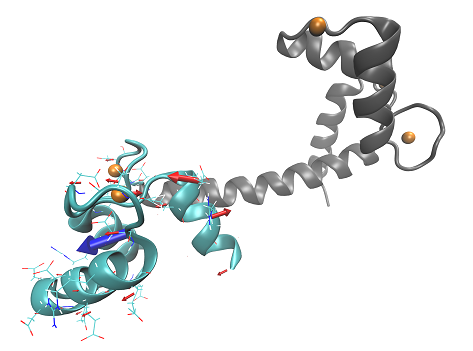Computational Biophysics & Bioinformatics - Dr. Emil Alexov Group
DelPhi Force Electrostatic force calculation web server
Delphi Force is a DelPhi-based script, allowing to calculate the electrostatic force between two objects, such as proteins, DNAs, lipids, small molecules, etc.
The calculation only requires two PQR files of the two objects. These files can be generated by our DelPhipKa webserver.
This server outputs the forces on each individual residue, and generates pictures to visualize the forces using arrows. In the pictures, the blue arrow shows the total force, the red arrows show the forces on individual residues. The server also provides VMD TCL scripts for the users to make their own pictures.
For questions and help, email to delphi@g.clemson.edu
The stand-alone script of DelPhiForce can be downloaded from here. If the use of DelPhi Force results to a publication, please cite:
Li L, Jia Z, Peng Y, Chakravorty A, Sun L, Alexov E.
DelPhiForce web server: electrostatic forces and energy calculations and visualization.
Bioinformatics. 2017 Nov 15;33(22):3661-3663. doi: 10.1093/bioinformatics/btx495.


DelPhi Force calculates the forces of atoms/residues on the "target" molecule under the electrostatic field generated by the "reference" molecule. For more detailed instructions, please check our paper and tutorial.
To calculate forces between two residues or a group of residues in a "reference" structure, use the Residues(s) Pairwise Interaction mode.
Standard PQR format contains the following information for each atom: index, name, residue name, 3D coordinates, charge, radius. You can generate a PQR file using a PDB file and our DelPhipKawebserver. This will allow you to create a PQR at desired pH.
Here we provide a sample PQR file: link
DelPhi Force calculates the forces of atoms/residues on the "target" molecule under the electrostatic field generated by the "reference" molecule. For more detailed instructions, please check our paper and tutorial.
To calculate forces between two residues or a group of residues in a "reference" structure, use the Residues(s) Pairwise Interaction mode.
Standard PQR format contains the following information for each atom: index, name, residue name, 3D coordinates, charge, radius. You can generate a PQR file using a PDB file and our DelPhipKawebserver. This will allow you to create a PQR at desired pH.
Here we provide a sample PQR file: link
2,302 Total views.